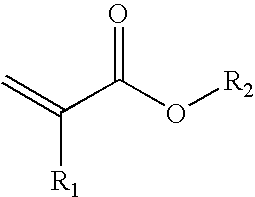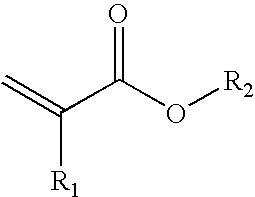Method for the production of cross-linkable acrylate contact adhesive materials
a technology of contact adhesives and cross-linked acrylates, which is applied in the direction of film/foil adhesives, domestic applications, applications, etc., can solve the problems of copolymerization of these compounds, limited adhesive properties, and drastic experimental conditions, and achieves high reactivity and very rapid reaction
- Summary
- Abstract
- Description
- Claims
- Application Information
AI Technical Summary
Benefits of technology
Problems solved by technology
Method used
Image
Examples
example 1
[0070]A reactor conventional for free-radical polymerizations was charged with 500 g of 2-ethylhexyl acrylate, 350 g of methyl acrylate, 70 g of butyl acrylate, 80 g of 4-methacryloyloxyethyl trimellitate anhydride and 540 g of acetone / special-boiling-point spirit (1:1). Nitrogen gas was passed through the mixture for 45 minutes, followed by double degassing, after which the reactor was heated to 58° C. with stirring and 0.2 g of azoisobutyronitrile (AIBN) was added. The external heating bath was then heated to 70° C. and reaction was carried out constantly at this external temperature. After a reaction time of 1 hour a further 0.2 g of AIBN was added. After 3 hours and 6 hours, in each case 250 g of acetone / special-boiling-point spirit (1:1) were used for dilution. The reaction was terminated after a time of 24 hours and the mixture was cooled to room temperature.
[0071]For adhesive testing, 100 g of the adhesive (based on solids) were blended with 0.4 g of bis(2,4,6-trimethylbenzoy...
example 2
[0073]A reactor conventional for free-radical polymerizations was charged with 10 g of acrylic acid, 375 g of 2-ethylhexyl acrylate, 200 g of methyl acrylate, 375 g of butyl acrylate, 40 g of itaconic anhydride and 290 g of acetone / special-boiling-point spirit (1:1). Nitrogen gas was passed through the mixture for 45 minutes, followed by double degassing, after which the reactor was heated to 58° C. with stirring and 0.2 g of azoisobutyronitrile (AIBN) was added. The external heating bath was then heated to 75° C. and reaction was carried out constantly at this external temperature. After a reaction time of 1 hour a further 0.2 g of AIBN was added. After 3 hours and 6 hours, in each case 250 g of acetone / special-boiling-point spirit (1:1) were used for dilution. The reaction was terminated after a time of 24 hours and the mixture was cooled to room temperature.
[0074]For adhesive testing, the adhesive was applied at a coverage of 50 g / m2 (based on solids) to a primed PET film (23 μm ...
example 3
[0075]A reactor conventional for free-radical polymerizations was charged with 20 g of acrylic acid, 810 g of 2-ethylhexyl acrylate, 50 g of methyl acrylate, 120 g of 4-methacryloyloxyethyl trimellitate anhydride and 540 g of acetone / special-boiling-point spirit (1:1). Nitrogen gas was passed through the mixture for 45 minutes, followed by double degassing, after which the reactor was heated to 58° C. with stirring and 0.2 g of azoisobutyronitrile (AIBN) was added. The external heating bath was then heated to 70° C. and reaction was carried out constantly at this external temperature. After a reaction time of 1 hour a further 0.2 g of AIBN was added. After 3 hours and 6 hours, in each case 250 g of acetone / special-boiling-point spirit (1:1) were used for dilution. The reaction was terminated after a time of 24 hours and the mixture was cooled to room temperature.
[0076]For adhesive testing, the adhesive was applied at a coverage of 50 g / m2 (based on solids) to a primed PET film (23 μ...
PUM
| Property | Measurement | Unit |
|---|---|---|
| Temperature | aaaaa | aaaaa |
| Temperature | aaaaa | aaaaa |
| Temperature | aaaaa | aaaaa |
Abstract
Description
Claims
Application Information
 Login to View More
Login to View More - R&D
- Intellectual Property
- Life Sciences
- Materials
- Tech Scout
- Unparalleled Data Quality
- Higher Quality Content
- 60% Fewer Hallucinations
Browse by: Latest US Patents, China's latest patents, Technical Efficacy Thesaurus, Application Domain, Technology Topic, Popular Technical Reports.
© 2025 PatSnap. All rights reserved.Legal|Privacy policy|Modern Slavery Act Transparency Statement|Sitemap|About US| Contact US: help@patsnap.com


